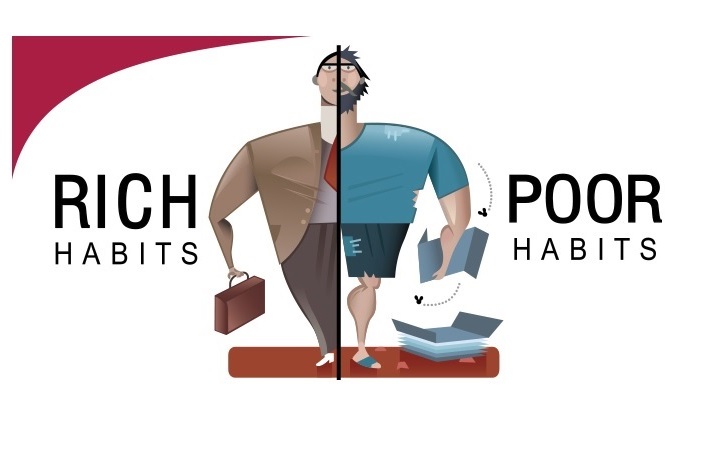
For five years, I studied the daily habits of 233 millionaires (177 were self-made millionaires) in order to find out what they were doing right. I also studied the daily habits of 128 individuals, struggling in poverty, in order to find out what they were doing wrong. I’ve shared these Rich Habits and Poor Habits with over 100 million people around the world through thousands of media interviews and various books – Rich Habits, Rich Kids, Change Your Habits Change Your Life and Rich Habits Poor Habits. Most of my books have become huge bestsellers. As a result, I’ve become a well-known habits and wealth expert, not only in the U.S., but around the world.
In my Rich Habits Study, I made two monumental discoveries:
- Discovery #1 – Your daily habits have a great deal to do with your financial circumstances – Some habits lift you up and help you grow wealth, while others drag you down and could put you in the poor house. The habits that lift you up, I call Rich Habits. The habits that drag you down, I call Poor Habits.
- Discovery #2 – There are 4 paths to wealth: Saver-Investor Path, Big Company Climber Path, Virtuoso Path and the Entrepreneur Path. Each path requires forging different Rich Habits and the path you take must be in alignment with your individual personality profile.
Recently, I’ve been spending quite a bit of my time in explaining how the Saver-Investor path works, due in large part to the release of my latest book, Effort-Less Wealth, which was written specifically for those who are interested in following the Saver-Investors path to creating their wealth.
What makes this path so special is that it is the only path that is available to almost everyone:
- The Saver-Investor Path does not require any unique set of skills – You don’t need to be born with unique innate talents and you don’t need to devote years to honing some special skill.
- The Saver-Investor Path requires no special knowledge – You don’t need to get a PhD or attend an expensive graduate school. You don’t need to go to an expensive college and you don’t need to even go to college at all.
- The Saver-Investor path does not demand that you take significant risks – You don’t have to go into debt or put up the equity in your house in order to become rich.
- The Saver-Investor Path does not require that you work long, oppressive work hours. and
- The Saver-Investor Path does not force you to isolate yourself from your family and friends in the pursuit of wealth.
The Saver-Investor Path is not only the easiest path to building wealth, it is also the guaranteed path to building wealth. But this easy, guaranteed path does have four requirements:
- Middle-Class Income – It’s hard to save when you are poor. Most of the poor are barely able to meet the costs of even a low standard of living. But, if you have a middle-class income and keep your standard of living low, this will give you the ability to save. And you need to save before you can invest.
- Discipline – The typical Saver-Investor saves 20% or more of their income and lives off what’s left. This requires discipline in saving first and discipline in minimizing how much money you spend, so that you can save.
- Consistency – Saver-Investors consistently save and consistently invest their savings so that their wealth can grow every year.
- Time – The typical Saver-Investor consistently saved and prudently invested their savings over an average of 32 years. So, if you want to become build wealth as a Saver-Investor, you need to begin doing so while you’re in your still in 20’s or early 30’s. If you start later in life, and still desire to retire wealthy, you will have to increase your savings rate by 10% for every ten years you failed to save. And you will have to work longer. For example, if you decide to pursue the Saver-Investor Path in your mid-thirties, you will have to increase your annual saving to 30% of your net income and work into your mid-sixties. If you start in your mid-forties, you will have to increase your annual savings to 40% of net income and work into your mid-seventies.
In my Rich Habits Study, the Saver-Investors accumulated an average of $3,260,000 over an average of 32 years.
Everyone’s life is a series of stages: childhood, primary school, secondary school, college for some, getting your first apartment, marriage, starting a family, buying your first family home, managing your growing family, balancing work and family while managing your career, empty nest stage and finally, the retirement stage.
Money mistakes you make in one stage can have a ripple effect, impacting one or more subsequent stages. Make too many money mistakes in any stage and you will find yourself in perpetual catch-up mode, the rest of your adult life.
Those who make the right decisions at every stage, prime themselves for financial success. In my latest book, Effort-Less Wealth, I explain exactly what you should be doing at every stage of your life in order to achieve financial success.
One of the prerequisites for the Saver-Investor Path is getting into the habit of saving 20% or more of your net pay. This requires that you maintain a cost or standard of living that is equal to 80% or less of your net pay. So, by saving 20% first, this “pay yourself first” strategy automatically forces you to live off of the remaining 80%.
Saving 20% first, creates your standard of living, which enables you to save, invest and build wealth.
My mission is to share my unique Rich Habits research in order to add value to your life and help you realize increased wealth, superior health, abundant success, fulfillment & happiness. If you find value in these articles, please share them with your inner circle and encourage them to Sign Up for my Rich Habits Daily Tips/Articles. No one succeeds on their own. Thank You!

Tom Corley is an accountant, financial planner, public speaker, and author of the books “Effort-Less Wealth: Smart Money Habits At Every Stage of Your Life” and “RichKids: How to Raise Our Children to Be Happy and Successful in Life“. Corley’s work has appeared on CNN, USA Today, The Huffington Post, SUCCESS Magazine, and many other media outlets and podcasts in the U.S. and 27 other countries. Tom is a frequent contributor to Business Insider and CNBC.
Comments